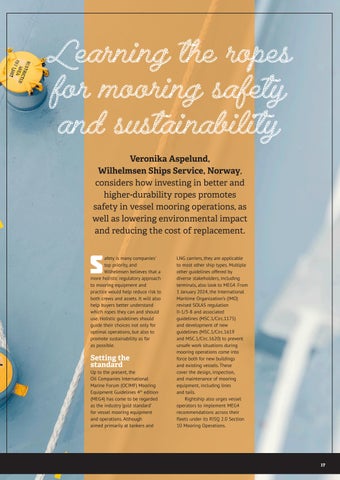Veronika Aspelund, Wilhelmsen Ships Service, Norway, considers how investing in better and higher-durability ropes promotes safety in vessel mooring operations, as well as lowering environmental impact and reducing the cost of replacement.
S
afety is many companies’ top priority, and Wilhelmsen believes that a more holistic regulatory approach to mooring equipment and practice would help reduce risk to both crews and assets. It will also help buyers better understand which ropes they can and should use. Holistic guidelines should guide their choices not only for optimal operations, but also to promote sustainability as far as possible.
Setting the standard
Up to the present, the Oil Companies International Marine Forum (OCIMF) Mooring Equipment Guidelines 4th edition (MEG4) has come to be regarded as the industry ‘gold standard’ for vessel mooring equipment and operations. Although aimed primarily at tankers and
LNG carriers, they are applicable to most other ship types. Multiple other guidelines offered by diverse stakeholders, including terminals, also look to MEG4. From 1 January 2024, the International Maritime Organization’s (IMO) revised SOLAS regulation II-1/3-8 and associated guidelines (MSC.1/Circ.1175) and development of new guidelines (MSC.1/Circ.1619 and MSC.1/Circ.1620) to prevent unsafe work situations during mooring operations come into force both for new buildings and existing vessels. These cover the design, inspection, and maintenance of mooring equipment, including lines and tails. Rightship also urges vessel operators to implement MEG4 recommendations across their fleets under its RISQ 2.0 Section 10 Mooring Operations.
17













